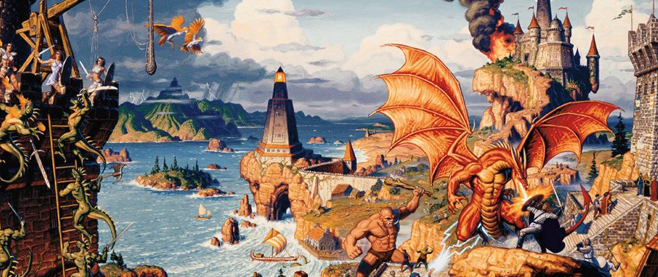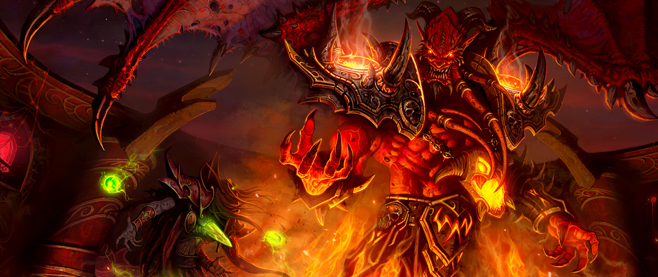
Massive: Origins Part 1
 I like my gamer friends best when they’re far away from me.
I like my gamer friends best when they’re far away from me.
Let me explain. This is not a comment on the personal hygiene of the gaming community. It’s just that, in the past, my best video game moments used to be crowding around a 30-inch television with my friends and taking turns launching a portly plumber into boiling hot lava in Super Mario Brothers. Other times, we’d team up in Golden Axe to see who could kick more potions out of the tiny thieving elves between stages.
Nowadays, being in the same location can actually limit our gaming options. If we’re hanging out together, can we all raid a dungeon in World of Warcraft? Well, no. Can we team up for some beta testing of Vindictus? Nope! What about leveling up our Lalafell botanists in Final Fantasy XIV? Oh wait…we wouldn’t do that if forced at gun point.
The merits of playing games with friends present physically vs. virtually is a debate for another article. However, this observation is an indicator of a growing trend: gamers flocking to massively multiplayer online (MMO) games. In this column I’d like to explore the origins of the MMO genre, its impact on the gaming community and my personal experiences playing these games.
The term MMO technically refers to all multiplayer games regardless of genre as long as it supports hundreds, if not thousands, of simultaneous players in a persistent world. The persistent world distinction is important to recognize. In other words, if you and your buddy launch a Starcraft 2 match, the game world you are playing in is created on the fly as you launch the game. When the match is over, that world is gone along with any impact you had on it. A persistent world continues to exist even after you log off. Other players can continue shooting, questing or gathering troops while you’re offline watching Policy Academy 4: Citizens on Patrol. This is perhaps why MMOs tend to have loyal communities that spend more hours on average playing these games than those of other genres. You may feel like you’re missing out or falling behind when you’re not logged in.
 Whether you love or hate MMOs, there’s no denying their colossal impact on the industry. Even if you look solely at roleplaying games that are MMOs (MMORPGs), the influence is pervasive. Blizzard announced recently that World of Warcraft alone has over 12 million active subscriptions. More people play WoW than the entire population of Cuba! Several other MMORPG games have a subscriber base in the millions, such as Aion, and the numbers continue to grow. The significance of MMORPGs can’t be marginalized.
Whether you love or hate MMOs, there’s no denying their colossal impact on the industry. Even if you look solely at roleplaying games that are MMOs (MMORPGs), the influence is pervasive. Blizzard announced recently that World of Warcraft alone has over 12 million active subscriptions. More people play WoW than the entire population of Cuba! Several other MMORPG games have a subscriber base in the millions, such as Aion, and the numbers continue to grow. The significance of MMORPGs can’t be marginalized.
So where did this juggernaut come from? Let’s take a journey.
The ancestors of MMORPGs were created in the ’70s and ’80s and largely consisted of text-based virtual worlds called MUDs (Multi-User Dungeons). Despite being almost exclusively text-based, these games were very popular on bulletin boards and included the same elements of modern day MMOs: roleplaying, player vs. player combat and online chat. The term “mob”—which is still widely used in MMOs to indicate a generic monster—originated from MUDs. A mob, short for “mobile object,” refers to any computer-controlled character that is generally meant to be slaughtered for experience points.
Building on the popularity of MUDs came a stream of graphical MUDs available on the early online services such as CompuServe, America Online and GEnie. The first of these was Neverwinter Nights , which launched in 1991 and cost $6 per hour to play. Some folks complain about the $12 per month they have to shell out to play today’s MMOs, but imagine paying per hour to log into a game that used the same engine as the old D&D Gold Box games!

In 1996, Meridian 59 launched. It was the first 3D online RPG and allowed players to view the game world through the eyes of their character. It was also the first to introduce a flat monthly subscription fee. The game still exists today as a result of its popularity and loyal fans.
The game credited for making MMORPGs popular is Richard Garriot’s brainchild, Ultima Online (UO). The Ultima franchise was already immensely popular and the online version gave fans a chance to play together in the virtual world of Britannia. The result was a smash hit with subscribers and a financial success topping anything that the genre had seen prior.
 Ultima Online was the first MMORPG game that I played and the experience was largely disappointing. My time in-game oscillated between two very different experiences: (1) endlessly searching for anything to fight—give me an orc, a bandit…heck, I’ll take a defenseless bunny! (2) Trying to fend off dozens of high-level creatures that would literally spawn out of thin air and surround me. At first I was grateful for the action, but when I realized I couldn’t beat any of them, it became much less interesting. The game was a lesson in frustration. Throngs of high-level characters would camp outside towns and slaughter any player that tried to exit. I really wanted to love UO, as I saw its great potential, but I just wasn’t having any fun with it.
Ultima Online was the first MMORPG game that I played and the experience was largely disappointing. My time in-game oscillated between two very different experiences: (1) endlessly searching for anything to fight—give me an orc, a bandit…heck, I’ll take a defenseless bunny! (2) Trying to fend off dozens of high-level creatures that would literally spawn out of thin air and surround me. At first I was grateful for the action, but when I realized I couldn’t beat any of them, it became much less interesting. The game was a lesson in frustration. Throngs of high-level characters would camp outside towns and slaughter any player that tried to exit. I really wanted to love UO, as I saw its great potential, but I just wasn’t having any fun with it.
The popularity of Ultima Online was a double-edged sword. Technical issues combined with balance issues hurt the overall health of the game. Massive lag would render the game unplayable during peak times. Cheating and hacks were abundant, destroying the in-game economy. Overcrowding and lack of real estate for player housing also contributed to the problems. UO was a huge success and yet a critical failure, a groundbreaking platform that collapsed under its own weight. But it was the perfect idea for other companies to learn from and improve—and that’s just what the folks at Sony Online Entertainment did with a tiny game called EverQuest.
——–
Join me next time as I discuss Everquestand the modern day MMOs as we continue to explore the history of the rapidly growing MMO genre.





